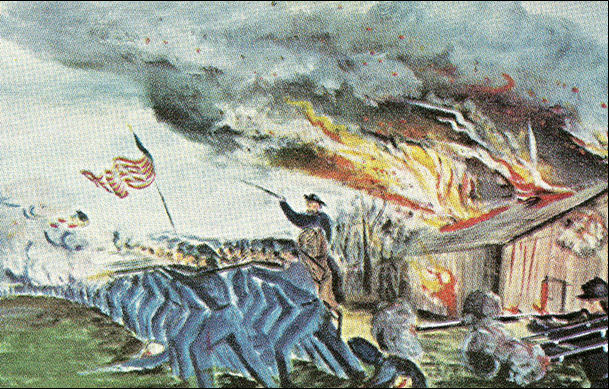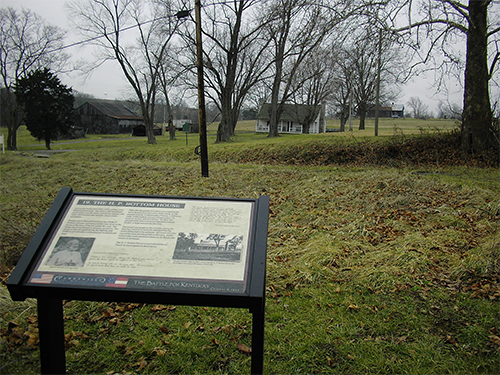Perryville Battlefield: Battle for the Barnyard
Perryville Battlefield: Battle for the Barnyard

(The October 2015 event will focus on military demonstrations and a reenactment at Maney’s Ridge.
The following featured battle will be reenacted on October 9, 2016)
The day was very hot for the thousands of men standing in their thick wool uniforms. A drought had stricken the area for quite some time. The Confederates were better off in that respect because they had access to the water sources – their canteens were full. The Union forces suffered under the same conditions, except their canteens were empty. Finding water sources for themselves and their horses became almost as high a priority as was driving the Confederate forces from Kentucky.
Artillery fire was present for a few hours prior, and then an explosion of musketry was heard to the north. The grey-clad men from Tennessee, Arkansas, Louisiana, and Mississippi moved forward to attack the formable Yankee positions around the Henry P. Bottom House. The 42nd Indiana Infantry had been sent down to the creek bed sometime before to rest and fill their canteens. The Union Artillery Battery at the top of the bluffs was commanded by Captain Cyrus Loomis. The Michiganders were armed with long-range rifled cannon. They also prided themselves on rapid firing. They were so good at rapid fire that they had used up most of their ammunition and had to retire as the Confederate infantry advanced. Taking their place on the ridge was the 10th Ohio infantry. The original Colonel of this veteran regiment was the published poet William H. Lytle. Lytle now commanded their Brigade. Across the Perryville/Mackville road to the south, on the ridge overlooking the Bottom house 120 yards away stood the 3rd Ohio Infantry. Their line stretched from the road, southward along a small post-and-rail fence. The right flank of Ohio regiment rested on a large barn. Waiting in reserve 250 yards behind the Ohioans was the 15th Kentucky Infantry regiment. These Unionists were from the Louisville area.

The Tennessee brigade commanded by Bushrod R. Johnson and the Louisiana brigade commanded by Daniel Adams attacked the Union positions at approximately the same time, but were unaware of each other. The resulting confusion caused these two brigades to fire on each other causing “friendly fire” casualties. Once this was sorted out, the two brigades converged on the hapless 42nd Indiana in the dry creek bed. After suffering numerous casualties, the Hoosiers extracted themselves from their predicament and took refuge on the reverse slope of the ridge behind the 10th Ohio where they sorted themselves out and reformed their line. The Confederates then pushed on towards the 3rd Ohio Infantry. As the attack developed, a Confederate artillery shell set the barn ablaze, blowing thick smoke down the line of the Ohioans. Some of the wounded Ohioans had sought refuge in the barn; instead they burned to death. The 3rd Ohio was fighting behind the post-and-rail fence and, just 60 yards away across a field of standing corn, Bushrod Johnson’s Tennesseans were fighting behind a stone fence. After almost 40% of the regiment was killed or wounded, the 3rd Ohio withdrew and their place was taken by the 15th Kentucky. Earlier, the Kentuckians had repeatedly asked the 3rd Ohio if they were ready to retire and let the 15th into the battle, now they got their chance. By the time the Kentuckians got into position, the barn was completely engulfed and, as a result of the dry weather, the entire hillside was burning. Under these conditions, the 15th Kentucky held the small rail fence. At one point, the entire color guard went down under the terrific small arms and artillery fire. Since the Colonel, the Lieutenant Colonel, and the Major of the regiment were already casualties, 19-year-old Captain James Brown Forman, of Company “C” found himself the ranking officer. He took the flag, and lashed what was left of the bullet-ridden staff to a fence rail. He carried the flag for the rest of the battle, using it to rally his remaining men. After the 15th had also suffered almost 40% in killed and wounded, they too withdrew from the field, leaving their dead on the burning hill.
Daniel Adams’ Louisiana brigade, more specifically, Austin’s Battalion of Louisiana sharpshooters, had worked their way behind the Yankees, hastening the battered Bluecoats on their way. On the north side of the road, Confederate General Patrick Cleburne brought his brigade up to take the heights away from the 10th Ohio. Realizing that a frontal assault would prove too costly, Cleburne placed the brigade’s battle flags with the advanced line of skirmishers, and ordered them to cautiously advance. The 10th Ohio, thinking this to be Cleburne’s main force, fired at the skirmishers. Ducking the volley, the skirmish line remained relatively unscathed. Cleburne immediately ordered his entire brigade to charge the hill and take it before the Ohioans had time to reload their muskets. This action, along with the flanking action of the Louisianans, broke the remaining Union defenders. Their Commander, Colonel H. William Lytle, was wounded in the head and left for dead, although he survived as a prisoner of war.
For the last 153 years, the ridge above the Bottom house where the barn and the small post-and-rail fence once stood was in private ownership and unavailable to the public. The Civil War Trust recently acquired this farm with the goal of eventually adding the acreage to the adjoining Perryville Battlefield State Historic Site. The park was recently given access to this property and is, with the assistance of the Friends of Perryville Battlefield State Historic Site, in the process of interpreting and restoring this area, so the public may walk and stand in the places these brave men stood a century-and-a-half before.
859-332-8631
www.parks.ky.gov/parks/historicsites/perryville-battlefield
www.friendsofperryville.org
www.civilwar.org/battlefields/perryville/perryville-2012


